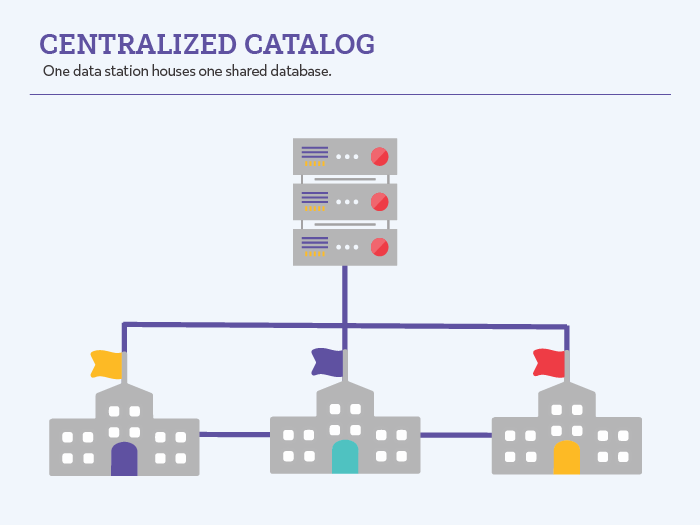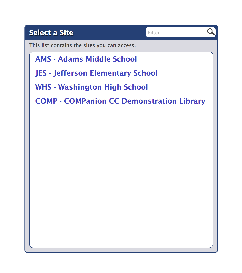What is a Centralized Catalog?
This page has been moved to https://support.goalexandria.com/alexandria-setup-options/centralized-catalog/
Since there is only one central patron database, a Centralized Catalog allows the most convenient access to interlibrary loans (ILL).
Those considering a Centralized Catalog should plan to address overlapping barcode ranges, policies, preferences and cataloging. When considering add-on features, all libraries must subscribe to the same services.
Things to Consider
Are you considering using or moving to a Centralized Catalog? Here are some things to note.
- District Administration. In a Centralized Catalog, one person sets the rules and maintains access levels. You should know who that person is or will be.
- Item Management. Since a Centralized Catalog is shared, one person needs to be in charge of the item records and cataloging. Otherwise, individual librarians could duplicate data or making conflicting changes, leading to troubles for everyone. Who creates the content? Who does the actual work of uploading and importing information? Depending on the institution, it might be a single teacher, an admin, a learning technologist, or an IT assistant. It's important to have an understanding of where the burden of work will fall and to have buy-in for this to happen.
- System vs Site Preferences. Some preferences affect all sites (System) while others only affect one site (Site). Your district administrator will need to learn about these capabilities so they can lead coordination among the libraries.
How a Centralized Catalog Affects Alexandria
A few things in Alexandria work differently if you have a Centralized Catalog.
Sites Management
For single site licenses, you will only ever maintain information for one site.
In a Centralized Catalog, you manage multiple sites. Sites Management in Alexandria allows you to view, modify, add, and remove information for each site record. One important piece of information you'll need to add for each site is their site code. This is a short, unique identifier that quickly tells both Alexandria and operators to which site a patron or item record belongs. For example, Adams Middle School might have a site code of AMS while Washington High School may have a site code of WHS.
Centralized Catalogs have a Union Site, which is bolded and at the top of the record list in Sites Management. However, the Union Site in a Centralized Catalog is special and doesn't operate like a normal site. It is used by Alexandria in two ways:
- As a place to assign patron or item records that do not have a designated site (if patrons or items are imported with missing or incorrect site codes).
- Defining default preferences; when a new site is created, the preferences from the Union Site are copied to the new site.
Preferences
As mentioned above, some preferences affect all sites (System) while others can be set up for individual sites (Site). Since System Preferences affect all sites, your district administrator should become familiar with them and set things up in a way that works for everyone.
System Preferences
- Patrons (except for defaults)
- Items (except for defaults)
- Circulation Settings
- Policies (rules that regulate how library resources are used by your patrons)
- SIS Integration
- Security (determine what parts of Alexandria operators and patrons can access and use)
- Setup
- Calendars
- Codes
- Services
- Advanced Bookings
- Z39.50
Site Preferences
- Patron Defaults
- Item Defaults
- Circulation (except for Circulation Settings)
- Researcher
- Sounds
You can see the preference type while in Alexandria! While viewing a preference, simply look right next to the Show All button near the top left-hand corner. You'll either see SYSTEM or SITE. Our Support Center pages also indicate preference types.
Circulation
The site selected when the current operator initially logs in is the current site for all proceeding circulation procedures and transactions. But you can always switch the current site by selecting Switch Site in the Actions Menu.
Since items and patrons can be from differing sites, there are several indications throughout Circulation letting you know to which site they belong. For example, a patron's site code will display under their picture when they are the current patron, and the Items out and Holds tabs identify an item's site.
In Transit
With a Centralized Catalog, you can place items in transit as they're moving between sites (to fulfill a hold elsewhere or return to their home site, for example). See Interlibrary Loans for more information on how this works in Alexandria.
Reports, Utilities, Exports
- You can use the site selection to specify which site to include.
- You get a few extra reports:
- And a couple extra utilities:
Items Management
Each copy's
contains a summary of its interlibrary transit history for the last two years.



